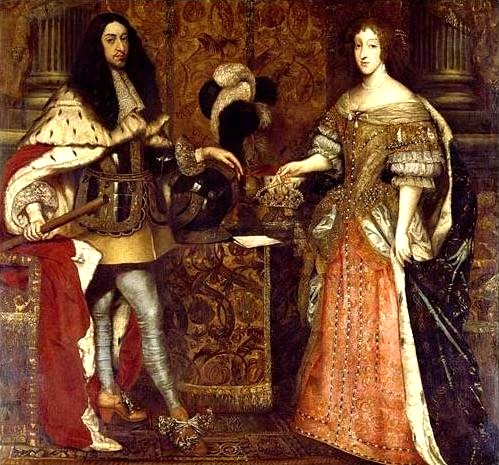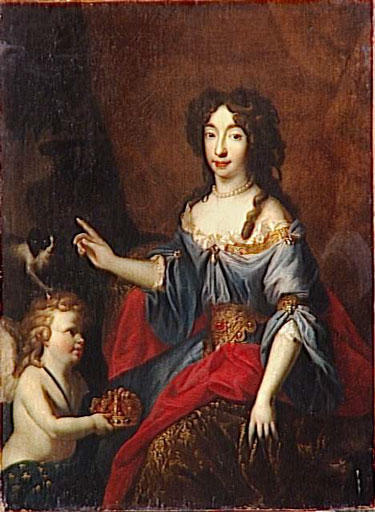by Susan Flantzer
© Unofficial Royalty 2023

Maria Anna Victoria, Dauphine of France; Credit – Wikipedia
Maria Anna Victoria of Bavaria was the wife of Louis, Le Grand Dauphin, the son of King Louis XIV of France and Maria Theresa of Spain. As the heir apparent to the French throne, Louis was styled Dauphin of France and was called Le Grand Dauphin after the birth of his son Louis who was called Le Petit Dauphin. Maria Anna Victoria was known as La Grande Dauphine. However, King Louis XIV outlived both his son and his grandson and when he died in 1715, Louis XIV was succeeded by his five-year-old great-grandson King Louis XV of France.

Maria Anna Victoria’s parents Ferdinand Maria, Elector of Bavaria and Henriette Adelaide of Savoy; Credit – Wikipedia
Maria Anna Christine Victoria was born on November 28, 1660, in Munich, Electorate of Bavaria, later the Kingdom of Bavaria, now in the German state of Bavaria. She was the eldest of the seven children and the eldest of the three daughters of Ferdinand Maria, Elector of Bavaria and Henriette Adelaide of Savoy. Maria Anna Victoria’s paternal grandparents were Maximilian I, Elector of Bavaria and his second wife Maria Anna of Austria. Her maternal grandparents were Vittorio Amedeo I, Duke of Savoy and Christine Marie of France.

Maria Anna Victoria with her brother Maximilian Emanuel; Credit – Wikipedia
Maria Anna Victoria had six siblings but only three survived childhood:
- Maximilian II Emanuel, Elector of Bavaria (1662 – 1726), married (1) Maria Antonia of Austria, had three children (2) Theresa Kunegunda Sobieska, had nine children
- Luise Margarete Antonie of Bavaria (1663 – 1665), died in early childhood
- Ludwig Amadeus Victor of Bavaria (born and died 1665), died in infancy
- Kajetan Maria Franz of Bavaria (born and died 1670), died in infancy
- Joseph Clemens of Bavaria, Archbishop-Elector of Cologne (1671 – 1723), an ordained priest
- Violante Beatrix of Bavaria (1673 – 1731) married Ferdinando de’ Medici, Grand Prince of Tuscany, no children
In 1668, eight-year-old Maria Anna Victoria was betrothed to her second cousin seven-year-old Louis, Dauphin of France, the only child of King Louis XIV of France and Maria Theresa of Spain to survive childhood. There was a family connection. Christine Marie of France, Maria Anna Victoria’s maternal grandmother was the sister of King Louis XIII of France, the paternal grandfather of Louis, Dauphin of France. That made Maria Anna Victoria’s mother Henriette Adelaide of Savoy and Louis’s father King Louis XIV of France first cousins.

Maria Anna Victoria in 1679 being handed the crown of the Dauphine of France by an angel signifying her coming marriage to the heir to the French throne the next year; Credit – Wikipedia
Maria Anna Victoria was carefully educated for her future role and looked forward to being the Dauphine of France. Besides her native language German, she was taught to speak French, Italian, and Latin. Maria Anna Victoria’s mother oversaw her daughter’s artistic and musical education, and Maria Anna Victoria wrote poetry, painted, sang, and played the harpsichord.

Maria Anna Victoria meeting her father-in-law King Louis XIV for the first time in March 1680, presumably, the groom is standing on the right; Credit – Wikipedia
Maria Anna Victoria and Louis, Dauphin of France were married in a proxy ceremony in Munich in the Electorate of Bavaria on January 28, 1680. The couple first met on March 7, 1680, the day of their religious wedding at Saint Etienne Cathedral in Châlons-sur-Marne, France. Maria Anna Victoria was the first Dauphine of France since Mary, Queen of Scots married the future King François II of France in 1558.

Louis and Maria Anna Victoria with their three sons: Louis on the right, Philippe in front, and Charles on his mother’s lap; Credit – Wikipedia
Maria Anna Victoria and Louis had three sons:
- Louis, Duke of Burgundy, Le Petit Dauphin (1682 – 1712), married Maria Adelaide of Savoy, had three children including the future King Louis XV of France
- Philippe, Duke of Anjou, later King Felipe V of Spain (1683 – 1746), married (1) Maria Luisa of Savoy, had four sons including King Luis I of Spain & King Fernando VI of Spain (2) Elisabeth Farnese of Parma, had six children including King Carlos III of Spain
- Charles, Duke of Berry (1686 – 1714), married Marie Louise Élisabeth of Orléans, had three children, all died before they were one month old.
After her marriage, Maria Anna Victoria took on the rank of her husband as a Fille de France (Daughter of France) and was entitled to the style Royal Highness and the title Madame la Dauphine. As the wife of the heir to the throne, she was the second most important woman at the French court after her mother-in-law Maria Theresa of Spain. Three years later, Maria Theresa died and Maria Anna Victoria then held the highest female position at court and was given the late queen’s apartments at the Palace of Versailles. King Louis XIV expected her to perform the duties of his late wife but Maria Anna Victoria’s ill health made it very difficult for her to perform these duties. King Louis XIV was completely unsympathetic to his daughter-in-law’s situation and, as it would turn out, falsely accused her of hypochondria.
The French court prized beauty and Maria Anna Victoria suffered from depression because she considered herself ugly, as did others at the French court, which contributed to her depression. Her husband had mistresses and illegitimate children so she began to lead a secluded life, spending time in her apartments. There Maria Anna Victoria spoke German, which her husband could not understand, with her friend, confidant, and Première femme de Chambre (First Chamber Maid, an office at the French court) Barbara Bessola. Maria Anna Victoria was friendly with Elisabeth Charlotte of the Palatinate, Duchess of Orléans, known as Liselotte, the second wife of Philippe I, Duke of Orléans, King Louis XIV’s only sibling. German was also Liselotte’s first language, and she also never felt comfortable at the French court, that was governed by rigorous etiquette and where all sorts of intrigues flourished.

The catafalque of Maria Anna Victoria for her funeral at the Cathedral Notre-Dame de Paris; Credit – Wikipedia
The births of her three sons and at least six miscarriages caused Maria Anna Victoria’s health to deteriorate. Her third son’s birth was very difficult, and on her deathbed, Maria Anna Victoria was convinced that her last childbirth had killed her. Maria Anna Victoria, aged twenty-nine, died on April 20, 1690, at the Palace of Versailles in Versailles, France. She was buried at the traditional burial site of the French royal family, the Basilica of St. Denis in the Paris suburb of Saint-Denis, France. An autopsy revealed several internal disorders that completely vindicated her complaints of chronic and severe illness. It is also probable that Maria Anna Victoria had tuberculosis.
In 1694, Maria Anna Victoria’s widower Louis, Le Grand Dauphin secretly married his mistress Marie Émilie de Joly de Choin, a lady-in-waiting at the French court. The marriage was not officially recognized and Marie Émilie did not participate in court life. On April 14, 1711, Louis, Le Grand Dauphin of France died from smallpox at the age of forty-nine. His eldest son Louis, Le Petit Dauphin, became the heir to the French throne but in less than a year, he too was dead from measles at the age of twenty-nine. Three years later, the five-year-old son of Louis, Le Petit Dauphin became King Louis XV of France upon the death of his great-grandfather King Louis XIV.
This article is the intellectual property of Unofficial Royalty and is NOT TO BE COPIED, EDITED, OR POSTED IN ANY FORM ON ANOTHER WEBSITE under any circumstances. It is permissible to use a link that directs to Unofficial Royalty.
Works Cited
- Ferdinand Maria, Elector of Bavaria (2023) Wikipedia. Available at: https://en.wikipedia.org/wiki/Ferdinand_Maria,_Elector_of_Bavaria (Accessed: 04 June 2023).
- Flantzer, Susan. (2019) Louis of France, Le Grand Dauphin, Unofficial Royalty. Available at: https://www.unofficialroyalty.com/louis-le-grand-dauphin/ (Accessed: 04 June 2023).
- Fraser, Antonia. (2006). Love and Louis XIV. New York: Nan A. Talese Doubleday.
- Maria Anna Victoria of Bavaria (2023) Wikipedia. Available at: https://en.wikipedia.org/wiki/Maria_Anna_Victoria_of_Bavaria (Accessed: 04 June 2023).
- Maria Anna Victoria von Bayern (2023) Wikipedia (German). Available at: https://de.wikipedia.org/wiki/Maria_Anna_Victoria_von_Bayern (Accessed: 04 June 2023).
- Marie-Anne de Bavière (1660-1690) (2023) Wikipedia (French). Available at: https://fr.wikipedia.org/wiki/Marie-Anne_de_Bavi%C3%A8re_(1660-1690) (Accessed: 04 June 2023).
